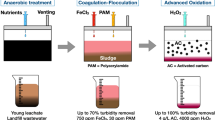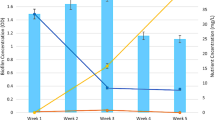Abstract
The continuous rise in production and applications of carbon nanotubes (CNTs) has grown a concern about their fate and toxicity in the environment. After use, these nanomaterials pass through sewage and accumulate in wastewater treatment plants. Since, such plants rely on biological degradation of wastes; their activity may decrease due to the presence of CNTs. This study investigated the effect of multiwalled carbon nanotubes (MWCNTs) on upflow anaerobic sludge blanket (UASB) microbial activity. The toxic effect on microbial viability, extracellular polymeric substances (EPS), volatile fatty acids (VFA), and biogas generation was determined. The reduction in a colony-forming unit (CFU) was 29 and 58 % in 1 and 100 mg/L test samples, respectively, as compared to control. The volatile fatty acids and biogas production was also found reduced. The scanning electron microscopy (SEM) and fluorescent microscopy images confirmed that the MWCNT mediated microbial cell damage. This damage caused the increase in EPS carbohydrate, protein, and DNA concentration. Fourier transform infrared (FTIR) spectroscopy results supported the alterations in sludge EPS due to MWCNT. Our observations offer a new insight to understand the nanotoxic effect of MWCNTs on UASB microflora in a complex environment system.








Similar content being viewed by others
References
Abbasi T, Abbasi SA (2012) Formation and impact of granules in fostering clean energy production and wastewater treatment in upflow anaerobic sludge blanket (UASB) reactors. Renew Sustain Energy Rev 16:1696–1708
Banyay M, Sarkar M, Graslund A (2003) A library of IR bands of nucleic acids in solution. Biophys Chem 104:477–488
Brar SK, Verma M, Tyagi RD, Surampalli RY (2010) Nanoparticles in wastewater and wastewater sludge-evidences and impacts. Waste Manag 30:504–520
Chen CZS, Cooper SL (2002) Interactions between dendrimer biocides and bacterial membranes. Biomaterials 23:3359–3368
Chen Y, Cheng JJ, Creamer KS (2008) Inhibition of anaerobic digestion process: a review. Bioresour Technol 99:4044–4064
Chung H, Son Y, Yoon TK, Kim S, Kim W (2011) The effect of multi-walled carbon nanotubes on soil microbial activity. Ecotoxicol Environ Saf 74:569–575
De Ibarra YS, Gaitero JJ, Erkizia E, Campillo I (2006) Atomic force microscopy and nanoindentation of cement pastes with nanotube dispersions. Physica Status solidi (a) 203:1076–1081
Dubois M, Gilles KA, Hamilton JK, Rebers PA, Smith F (1956) Colorimetric method for determination of sugars and related substances. Anal Chem 28:350–356
Garcia A, Delgado L, Tora JA, Casals E, Gonzalez E, Puntes V, Font X, Carrera J, Sanchez A (2012) Effect of cerium dioxide, titanium dioxide, silver, and gold nanoparticles on the activity of microbial communities intended in wastewater treatment. J Hazard Mater 199–200:64–72
Gottschalk F, Sonderer T, Scholz RW, Nowack B (2009) Modeled environmental concentrations of engineered nanomaterials (TiO2, ZnO, Ag, CNT, Fullerenes) for different regions. Environ Sci Technol 43(24):9216–9222
Gottschalk F, Sun T, Nowack B (2013) Environmental concentrations of engineered nanomaterials: review of modeling and analytical studies. Environ Pollut 181:287–300
Guibaud G, Comte S, Bordas F, Dupuy S, Baudu M (2005) Comparison of the complexation potential of extracellular polymeric substances (EPS), extracted from activated sludges and produced by pure bacteria strains, for cadmium, lead and nickel. Chemosphere 59:629–638
Gupta VK, Saleh TA (2013) Sorption of pollutants by porous carbon, carbon nanotubes and fullerene—an overview. Environ Sci Pollut R 20(5):2828–2843
Hai R, Wang Y, Wang X, Du Z, Li Y (2014) Impacts of multiwalled carbon nanotubes on nutrient removal from wastewater and bacterial community structure in activated sludge. PLoS ONE 9(9):e107345. doi:10.1371/journal.pone.0107345
Hou J, Miao L, Wang C, Wang P, Ao Y, Lv B (2014) Effect of CuO nanoparticles on the production and composition of extracellular polymeric substances and physicochemical stability of activated sludge flocs. Bioresour Technol. doi:10.1016/j.biortech.2014.11.020
Hyung H, Fortner JD, Hughes JB, Kim JH (2007) Natural organic matter stabilizes carbon nanotubes in the aqueous phase. Environ Sci Technol 41(1):179–184
IRP, Innovative Research and Products (2011) Inc. Production and applications of carbon nanotubes, carbon nanofibers, fullerenes, graphene, and nanodiamonds: A Global Technology Survey and Market Analysis, ET-113; p 531
Jaisi DP, Saleh NB, Blake RE, Elimelech M (2008) Transport of single-walled carbon nanotubes in porous media: filtration mechanisms and reversibility. Environ Sci Technol 42(22):8317–8323
Jia G, Wang HF, Yan L, Wang X, Pei RJ, Yan T, Zhao YL, Guo XB (2005) Cytotoxicity of carbon nanomaterials: single-wall nanotube, multi-wall nanotube, and fullerene. Environ Sci Technol 39:1378–1383
Joseph T, Morrison M (2006) Nanotechnology in Agriculture and Food, Institute of Nanotechnology. www.nanoforum.org, (access 01/13/2012)
Kang S, Pinault M, Pfefferle LD, Elimelech M (2007) Single walled carbon nanotubes exhibit strong antimicrobial activity. Langmuir 23(17):8670–8673
Kang S, Herzberg M, Rodrigues DF, Elimelech M (2008a) Antibacterial effects of carbon nanotubes: size does matter! Langmuir 24(13):6409–6413
Kang S, Mauter SM, Elimelech M (2008b) Physiochemical determinants of multiwalled carbon nanotube bacterial cytotoxicity. Environ Sci Technol 42:7528–7534
Kang S, Mauter MS, Elimelech M (2009) Microbial cytotoxicity of carbon-based nanomaterials: implications for river water and wastewater effluent. Environ Sci Technol 43:2648–2653
Kannepalli S, Fennell DE, Huang W (2008) Effect of double walled carbon nanotubes on a TCE-dechlorinating culture. The 236th ACS National Meeting, Philadelphia, PA, August 17–21, 2008
Kumar A, Pandey AK, Singh SS, Shanker R, Dhawan A (2011) Engineered ZnO and TiO2 nanoparticles induce oxidative stress and DNA damage leading to reduced viability of Escherichia coli. Free Rad Biol Med 51:1872–1881
Lam CW, James JT, McCluskey R, Arepalli S, Hunter RL (2006) A review of carbon nanotube toxicity and assessment of potential occupational and environmental health risks. Crit Rev Toxicol 36(3):189–217
Latif MA, Ghufran R, Wahid ZA, Ahmad A (2011) Integrated application of upflow anaerobic sludge blanket reactor for the treatment of wastewaters. Water Res 45(16):4683–4699
Lee WJ, Maiti UN, Lee JM, Lim J, Han TH, Kim SO (2014) Nitrogen-doped carbon nanotubes and graphene composite structures for energy and catalytic applications. Chem Commun 50:6818–6830
Li LL, Tong ZH, Fang CY, Chu J, Yu HQ (2015) Response of anaerobic granular sludge to single-wall carbon nanotube exposure. Water Res 70:1–8
Liu H, Fang HHP (2002) Extraction of extracellular polymeric substances (EPS) of sludges. J Biotechnol 95:249–256
Lowry OH, Rosebrough NJ, Farr AL, Randall RJ (1951) Protein measurement with the folin-phenol reagent. J Biol Chem 193:265–275
Lowry GV, Gregory KB, Apte SC, Lead JR (2012) Transformations of nanomaterials in the environment. Environ Sci Technol 46:6893–6899
Luongo LA, Zhang X (2010) Toxicity of carbon nanotubes to the activated sludge process. J Hazard Mater 178:356–362
Mamba G, Mbianda XY, Mishra AK (2014) Gadolinium nanoparticle-decorated multiwalled carbon nanotube/titania nanocomposites for degradation of methylene blue in water under simulated solar light. Environ Sci Pollut R 21(8):5597–5609
Mann EE, Rice KC, Boles BR, Endres JL, Ranjit D, Chandramohan L, Tsang LH, Smeltzer MS, Horswill AR, Bayles KW (2009) Modulation of eDNA release and degradation affects Staphylococcus aureus biofilm maturation. PLoS ONE 4(6):e5822. doi:10.1371/journal.pone.0005822
Montgomery HAC, Dymock JF, Thom NS (1962) The rapid colorimetric determination of organic acids and their salts in sewage-sludge liquor. Analyst 87:949–955
Mu H, Zheng X, Chen Y, Chen H, Liu K (2012) Response of anaerobic granular sludge to a shock load of zinc oxide nanoparticles during biological wastewater treatment. Environ Sci Technol 46:5997–6003
Mueller N, Nowack B (2008) Exposure modeling of engineered nanoparticles in the environment. Environ Sci Technol 2008(42):4447–4453
Musee N, Thwala M, Nota N (2011) The antibacterial effects of engineered nanomaterials: implications for wastewater treatment plants. J Environ Monit 13:1164–1183
Pammi M, Liang R, Hicks J, Mistretta TA, Versalovic J (2013) Biofilm extracellular DNA enhances mixed species biofilms of Staphylococcus epidermidis and Candida albicans. BMC Microbiol 13:257
Pasquini LM, Sekol RC, Taylor AD, Pfefferle LD, Zimmerman JB (2013) Realizing comparable oxidative and cytotoxic potential of single- and multiwalled carbon nanotubes through annealing. Environ Sci Technol 47(15):8775–8783
Pekin G, Haskok S, Sargın S, Gezgin Y, Eltem R, Ikizoglu E, Azbar N, Sukan FV (2010) Anaerobic digestion o f Aegean olive mill effluents with and without pretreatment. J Chem Technol Biotechnol 85:976–982
Pereira MM, Mouton L, Yepremian C, Coute A, Lo J, Marconcini JM, Ladeira LO, Raposo NRB, Brandao HM, Brayner R (2014) Ecotoxicological effects of carbon nanotubes and cellulose nanofibers in Chlorella vulgaris. J Nanobiotechnol 12:15
Petersen EJ, Zhang L, Mattison NT, O'Carroll DM, Whelton AJ, Uddin N et al (2011) Potential release pathways, environmental fate, and ecological risks of carbon nanotubes. Environ Sci Technol 45(23):9837–9856
Rodrigues DF, Jaisi DP, Elimelech M (2013) Toxicity of functionalized single-walled carbon nanotubes on soil microbial communities: implications for nutrient cycling in soil. Environ Sci Technol 47:625–633
Siedlecka EM, Kumirska J, Ossowski T, Glamowski P, Gołębiowski M, Gajdus J, Kaczyński Z, Stepnowski P (2008) Determination of volatile fatty acids in environmental aqueous samples. Pol J Environ Stud 17(3):351–356
Sobolev K, Gutierrez MF (2005) How nanotechnology can change the concrete world. Am Ceram Soc Bull 84:16–19
Thomas VC, Thurlow LR, Boyle D, Hancock LE (2008) Regulation of autolysis dependent eDNA release by Enterococcus faecalis extracellular proteases influences biofilm development. J Bacteriol 190(16):5690–5698
Wingender J, Neu TR, Flemming HC (1999) Microbial extracellular polymeric substances: characterization, structures and function. Springer, Berlin
Yang S, Li X (2009) Influences of extracellular polymeric substances (EPS) on the characteristics of activated sludge under non-steady-state conditions. Process Biochem 44:91–96
Yenigun O, Kizilgun F, Yilmazer G (1996) Inhibition effects of zinc and copper on volatile fatty acid production during anaerobic digestion. Environ Technol 17(11):1269–1274
Young YF, Lee HJ, Shen YS, Tseng SH, Lee CY, Tai NH, Chang HY (2012) Toxicity mechanism of carbon nanotubes on Escherichia coli. Mater Chem Phys 134:279–286
Zardini HZ, Davarpanah M, Shanbedi M, Amiri A, Maghrebi M, Ebrahimi L (2014) Microbial toxicity of ethanolamines-multiwalled carbon nanotubes. J Biomed Mater Res A 102:1774–1781
Zhang W (2014) Nanoparticle aggregation: principles and modeling. Adv Exp Med Biol 811:19–43. doi:10.1007/978-94-017-8739-0_2
Acknowledgments
We thank Chemical Engineering Department, SVNIT, Surat, for providing basic infrastructure for work; MHRD for providing fellowship, Sophisticated Analytical Instrument Facilities, IIT-Bombay, Shree Dhanvantary Pharmacy College, Surat, and Gene care Lab, Surat, for analytical facilities.
Compliance with ethical standards
We would like to affirm that the study was carried out at Chemical Engineering Department, Sardar Vallabhbhai National Institute of Technology, Surat, India. Results consist of a part of our ongoing work and have not been published previously and are not under consideration for publication elsewhere. We also affirm the approval by all authors and tacitly or explicitly by the responsible authorities where the work was carried out, and that, if accepted, it will not be published elsewhere in the same form. No human and/or animal was used as an experimental subject for the present work.
Conflict of interest
The authors declare that there is no conflict of interest
Author information
Authors and Affiliations
Corresponding author
Additional information
Responsible editor: Robert Duran
Rights and permissions
About this article
Cite this article
Yadav, T., Mungray, A.A. & Mungray, A.K. Effect of multiwalled carbon nanotubes on UASB microbial consortium. Environ Sci Pollut Res 23, 4063–4072 (2016). https://doi.org/10.1007/s11356-015-4385-y
Received:
Accepted:
Published:
Issue Date:
DOI: https://doi.org/10.1007/s11356-015-4385-y




